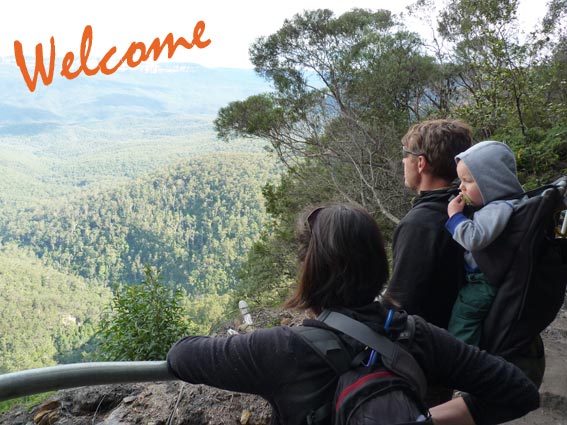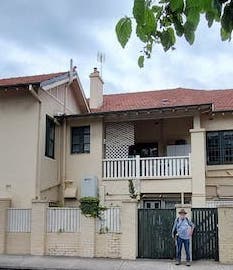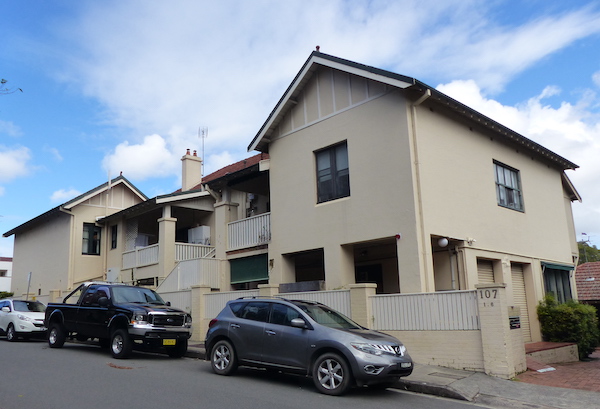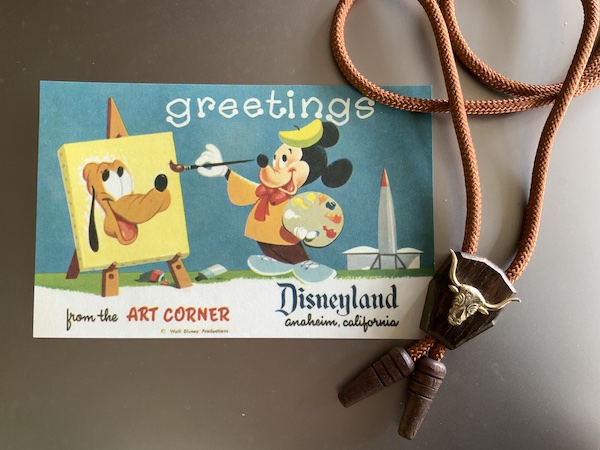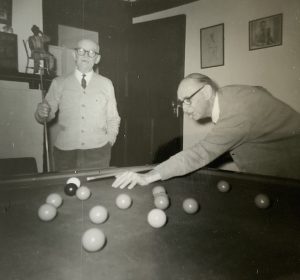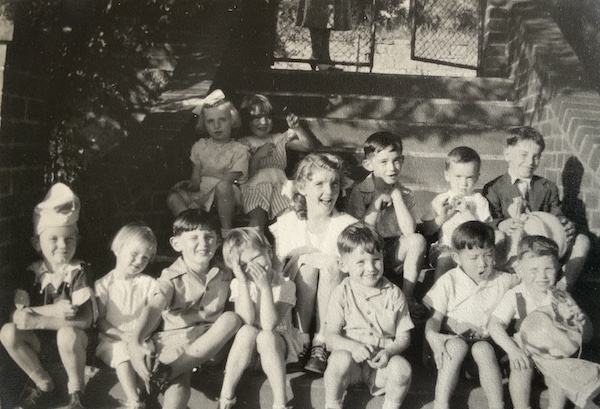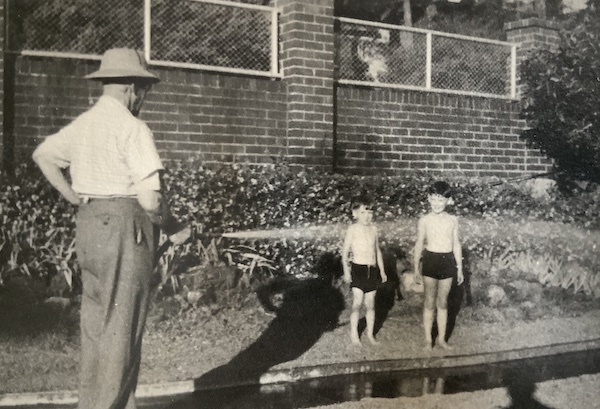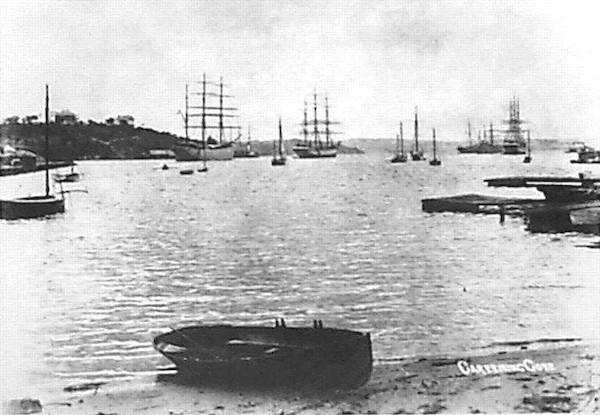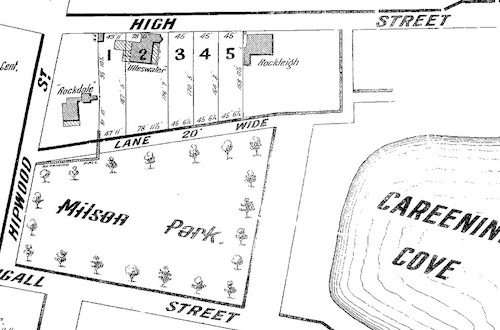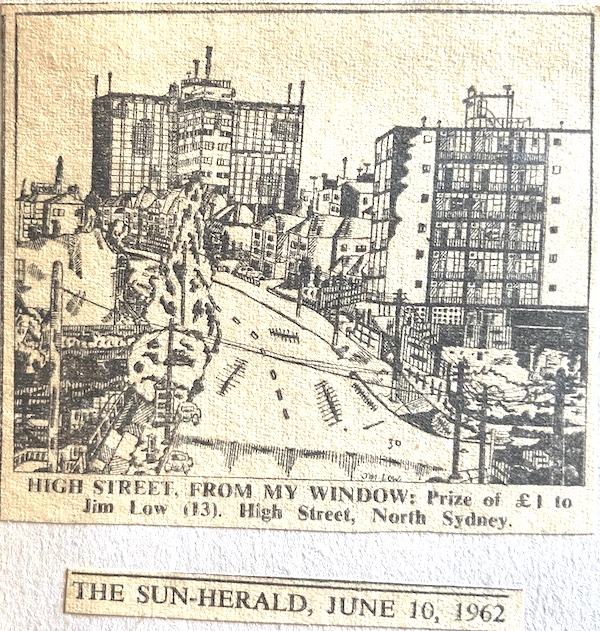Faded photos I still keep
Into the past I often creep
To recreate from what I see
The environment that moulded me.
© Jim Low November 2022
For my first twenty-two years, I lived with my family in flat 4, one of five, large living spaces that made up Ulleswater. The address of this rambling, old, two storey building is 107 High Street, North Sydney in New South Wales. Those childhood and adolescent years were spread through the 1950s and 1960s. A dominant memory that always typifies Ulleswater for me was its great sense of community. It was a safe place where things operated somewhat like an extended family.
The Grimish family looked after landlord duties. As far as I know, my father paid rent to them. Joseph and Vera Grimish lived on the second floor next to our flat. We always referred to them as Mr Joe and Aunty Vera. Aunty Vera was a great support to my mother during the early childhood years of both my older brother John and me. She and Mr Joe appear in a number of our family photographs. Her brother Randolf, known to everyone as Chunny, was my godfather. He did not live at Ulleswater. Mr and Mrs Grimish had a married daughter named Jan who lived in Hong Kong but when her husband sadly died she returned with her two young daughters, Carolyn and Annette, to live with her parents. They lived for a number of years at Ulleswater until Jan remarried and they moved to Newcastle. While at Ulleswater Carolyn and Annette became our good playmates. I can remember often going to the North Sydney Olympic Pool together. And of course we all played in Ulleswater’s ample garden spaces.
Mr Joe built his granddaughters a wooden cubby house on the Milson Park side of the property. Built next to a grassed area set aside for clothes lines, this was where our washing was hung. This area brings back memories of honeysuckle, lantana and the purple petals of a large jacaranda tree. The cubby was situated under the jacaranda’s spreading branches and was aptly named Jacaranda Cottage. Mr Joe painted the name on a sign above the door, giving the cubby real character and warmth. It was still there long after the girls left. When some noisy building work was being carried out in High Street, I remember going down to the cubby to study for some high school exams.
Next to Aunty Vera and Mr Joe lived Mr and Mrs Robertson. Their daughter Joan, when holidaying overseas in USA, sent my brother and me postcards from Disneyland. Much to my delight mine had a drawing of Mickey Mouse dressed as an artist. She knew I liked drawing. On her return she kindly brought each of us back a special present from Disneyland, a cowboy’s string necktie with a wooden toggle. Mine had the head of a steer on the toggle. I still have the necktie and postcard. Mrs Robertson was not a well lady and when she died, her husband remarried and had another daughter. My brother and I sometimes babysat for the Robertsons.
On the ground floor, immediately below our flat, lived Victor and Ivy Randall. Mrs Randall’s sister Joyce lived with them. My brother and I shared a bedroom and for as long as I can remember, Joyce shared the room directly under our bedroom with her partner Stan. When we made any excessive noise above them, they would bang on the ceiling with a broom handle to shut us up.
Living at Ulleswater had a distinct community feel. I used to do the weekly messages for Joyce when I was in primary and high school. Most times it was after school on a Friday. Joyce worked as an usherette at the Regent Theatre in George Street, one of Sydney’s now demolished, grand, old theatres. During school holidays she would treat my brother and me to free matinee shows, sitting us in the dress circle. One of the films I remember seeing in the early 1960s was Summer Holiday, starring the English singer Cliff Richards and his band the Shadows. This band was an early favourite of mine.
Joyce and Stan regularly went to the Sydney Stadium to hear the latest overseas popular singers. In October 1957 they kindly took John and me to see a rock and roll show featuring Little Richard, Gene Vincent and Eddie Cochran. An enduring memory of the evening is that of Little Richard shedding about half a dozen different coloured, lightweight suits during his performance. As well as being a popular music venue, the Stadium was also used for boxing matches. Despite featuring a revolving stage and being much loved by many Sydney-siders, it was a pretty rough and ready venue. A decade later I returned to the Stadium. This time it was not for music but rather a rally against the Vietnam War. For over sixty years this round, iron shed had been a landmark on Sydney’s eastern approach. It was demolished to make way for the Eastern Suburbs railway line in 1970.
I remember also the times Joyce invited me down to listen to some of her new 45rpm records. Elvis Presley’s Love Me Tender was one I recall hearing. On Saturday afternoons, besides the races on the radio coming from their room, you would often hear Stan playing his banjo.
When we got television Joyce and Stan would regularly come up on Friday evenings and watch The Bobby Limb Show and Bonanza with us. On Sunday evenings they would return to enjoy an Australian musical variety show with an English compere called Digby Wolfe.
Mr and Mrs Esserman lived in the other ground floor flat on the Milson Park side of the building. They had two grown-up daughters. Mrs Esserman’s brother Baron Grimish also lived with them. Mrs Esserman shared ownership of Ulleswater with her other brother Joseph Grimish.
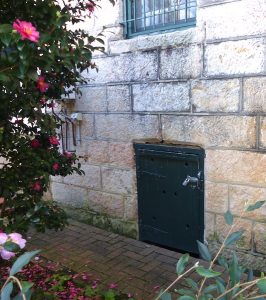 On the outside wall underneath the Esserman’s flat was a small, wooden door. It was the entrance to a dark and dusty, storage area. Just inside this cellar was a supply of coke. I remember it as a scary space, especially for a young, impressionable boy like me. Any monster, I thought, could be lurking back there in the cellar’s darkness! I wasted no time whenever I had to fill our shuttle with coke for the ‘Cosy’ fire heater. On a return visit in April 2022 I went looking for the cellar door. An attractive hedge now conceals the small, padlocked door. The surrounding, cement render had been scraped away, revealing the original, large sandstone blocks of what was once Llanarmon, the original name of the residence.
On the outside wall underneath the Esserman’s flat was a small, wooden door. It was the entrance to a dark and dusty, storage area. Just inside this cellar was a supply of coke. I remember it as a scary space, especially for a young, impressionable boy like me. Any monster, I thought, could be lurking back there in the cellar’s darkness! I wasted no time whenever I had to fill our shuttle with coke for the ‘Cosy’ fire heater. On a return visit in April 2022 I went looking for the cellar door. An attractive hedge now conceals the small, padlocked door. The surrounding, cement render had been scraped away, revealing the original, large sandstone blocks of what was once Llanarmon, the original name of the residence.
Our ‘Cosy’ fire heater sat on the hearth of a former, open fire place. This old fire place was in a large room in the middle of our flat. We always referred to it as ‘the billiard room’. It was there that my father’s three-quarter size Heron and Smith billiard table literally filled the room. When not in use it was covered by a large, green plastic sheet and then a large material cover, both of these sewn by my mother. The plastic sheet was there to ensure that no moisture ever penetrated the table’s heavy, slate blocks. We learnt quickly as children that no beverages could ever be placed on this table. In its covered guise, it served as a convenient work space for John and me. We would always do our school and university assignments there whilst listening to the radio or the record player.
During my childhood the billiard room was definitely the centre of our home. Up until a television set muscled its way into the flat around 1960 or 1961, the billiard room reigned supreme.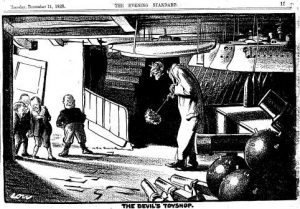 Its walls were adorned with my Uncle David’s caricatures, many of these being facsimile prints from the English newspaper The Evening Standard. Later to be Sir David Low, his black-and-white portrayals of H.G.Wells, Bernard Shaw, Matthew Arnold and other literary and political contemporaries seemed to scrutinise our every movement. The largest, and for me always the most mesmerising of these drawings, was an original cartoon called The Devil’s Toyshop. The cartoon, drawn by my uncle in the late 1920s, always reminded me of Ulleswater’s previously mentioned cellar. The ‘toyshop’ of armaments is depicted by my uncle as being a dark, dingy and ominously threatening space. It now hangs in my own home.
Its walls were adorned with my Uncle David’s caricatures, many of these being facsimile prints from the English newspaper The Evening Standard. Later to be Sir David Low, his black-and-white portrayals of H.G.Wells, Bernard Shaw, Matthew Arnold and other literary and political contemporaries seemed to scrutinise our every movement. The largest, and for me always the most mesmerising of these drawings, was an original cartoon called The Devil’s Toyshop. The cartoon, drawn by my uncle in the late 1920s, always reminded me of Ulleswater’s previously mentioned cellar. The ‘toyshop’ of armaments is depicted by my uncle as being a dark, dingy and ominously threatening space. It now hangs in my own home.
A large, gold-framed photograph of the Sydney Harbour Bridge captured at the meeting of the northern and southern arches, hung high above the picture railing on one of the walls. A gold-faced, plaster head of Sir Charles Kingsford Smith, lovingly made by my father, stared from another wall, as if trying to decide which expanse of sky to conquer next. Meanwhile Smithy’s portrait also graced another picture frame in which he drifts in the clouds along with some aeroplanes. A portrait of a reflective, old Maori chief also adorned a large part of a wall in the room. I believe it was titled A Warm Day.
A wall rack housed my father’s billiard cues and a wooden scoreboard was unobtrusively attached to another wall. A variety of interesting and unusual ornaments and knick-knacks surrounded the various surfaces in the billiard room. Of this collection the beautifully crafted, ceramic depiction of two black tennis players with their detailed clothing and racquets, astride cane chairs, were the most obviously noticeable. Apparently they had been part of a shop promotion when my grandfather was a chemist in Auckland, New Zealand. Colourful plates in varying sizes rested on wooden plate holders made by my father.
In the backroom, originally an open verandah which my father had glassed in, were other memorable pictures. The Laughing Cavalier gazed enigmatically from one wall while on another, a gathering of rotund Lords of the Admiralty hovered over a map-covered table pondering their next ‘expansion of the Empire’. And if that wasn’t enough, there were two sepia coloured works showing some priests fishing and the next minute devouring their catch. As well as being our dining room, and in one corner housing my father’s desk, this area later became our television room. As you can see, even without a television, there were always plenty of visual stimuli to keep a young mind active.
Every Friday evening most of the male residents of Ulleswater would meet in our flat to play snooker and billiards. My father would prepare the table beforehand by rolling back the covers and carefully ironing and brushing the prized, green tablecloth. This was like a ritual and I always enjoyed watching it. At the same time the women folk would play mahjong with my mother around the dining room table in our backroom. During the evening they all would come together for a supper, made up of everyone’s contributions.
The guests usually arrived between 7.30 and 8.00pm. By that time John and I had to retire to our bedroom. We were always under strict instructions from my mother to be quiet and get to sleep as soon as possible. This was not always easy as our bedroom was right next to the billiard room. Even though we kept our door shut, the smell of cigarette and cigar smoke wafted under it during the evening. I am sure this is why neither my brother nor I ever took up smoking.
My father later taught us to play both billiards and snooker on this table. We soon knew when to get out the small cue and ‘jigger’ if ever we found ourselves in a tight spot physically. We also were quite proficient when it became necessary to use the ‘spider’. And I always tried to avoid ever getting ‘snookered’ throughout my life!
Being set on a large block of land, Ulleswater had many unique places to play, some hidden away, others quite obvious. Some of them were also deemed ‘out of bounds’ for us. But the occasional secret visits around the borders of the property always afforded new surprises. The most popular playing area was a large, grassed yard which was indeed a child’s delight. This grassed area was broken by two rather formal flower beds. The largest of these, closest to the house, had a circular, cement border. At its centre it once featured an ornamental fountain. Around the yard was an oval shaped, concrete pathway and we always enjoyed riding continuously around it on our bikes and scooters. This expansive garden also proved an ideal place for our birthday parties. It was there too in May each year that our Empire Day firecracker nights started literally with a bang!
Along Ulleswater’s High Street side, there were garden beds that backed onto a tall, solid brick and wire fence. There was a wide, concrete staircase at the far end of this garden which ascended to High Street. It was there that we always sat with our friends and relatives for our birthday party photographs.
I used to hit a tennis ball against these stairs for hours on end. Your accuracy increased as you aimed to hit only the vertical part of each step. If you happened to hit the edge of the step, the ball would rebound erratically. Often after watching the Davis Cup, which each year was televised live on Boxing Day and subsequent days, my brother and I would go down to the garden stairs. In the summer heat, we would happily spend time hitting balls against them. We were protected from direct sunlight by the dappled shade from the canopy of a very large tree which grew next to the stairs in the corner of the property.
Under this tree’s protective growth, where no grass grew, was the area known as ‘the dirt’. During our childhood years we spent many hours building roadways and pushing our Dinky toy cars over the rough, dirt paths that we fashioned around the tree’s thick trunk. We dug and built things there, playing contentedly with our lead toy soldiers, cowboys and ‘Indians’. ‘The dirt’ was always a favourite place to play. In summer it was shady and cool and we could get as dirty as we liked.
Next to this corner of the garden was a flat, grassed area upon which was set a metal, tent-shaped frame. We were constantly warned never to swing on this metal frame. I think this structure could have originally been used as a fernery. I can remember when one of the Esserman daughters had her wedding ceremony there. For that special occasion it was decked out with a canvas covering.
Our closed-in verandah overlooked the garden and this meant that my parents had a fair idea what we were up to when we played there. I have a number of photographs from my childhood album that feature the garden. One shows John and me in our swimming costumes being hosed by Mr Esserman as he watered the garden. This was always a treat on a hot, summer’s day. As children we spent countless, happy hours playing in Ulleswater’s large garden.
The mention of old Mr Esserman reminds me of the Melbourne Cup sweeps he ran each year for all the residents of Ulleswater. At one stage in his life he had actually been a bookmaker. He had an interest in horses and horse racing and seems to have passed some of this on to my brother.
In 1967 Ulleswater was sold to a development company. As I remember it, the word around the flats was that the new owners planned to demolish the building and construct high rise apartments on the site. We had already seen this happen recently on the other side of our street. Two high rise apartment blocks overshadowed the Ulleswater garden. However, the company’s plans were thwarted by the local council ruling that high rise buildings were not to be constructed on our side of the street. This necessitated a change of plans for the new owners and perhaps explains why my parents did not have to leave Ulleswater until 1973. In that year they moved to a new unit in Waverton. This became the first home they had ever owned.
Ulleswater’s new owners decided to do some necessary refurbishments to the old flats and sell them off under strata title. This had already begun with the Esserman’s flat, before I left to go teaching in the country in 1970. Some serious renovation work was definitely needed to our old flat. The spongy, floor boards under the carpet in sections of my parents’ bedroom definitely needed replacing. We used to joke that one morning we would find my folks sleeping with the Randalls, their bedroom being directly underneath.
Around this time the large garden area of the Ulleswater property was sold by the developers as a separate block. A large residence now sprawls over this once special space. I always felt that the removal of the garden stopped the old house from breathing and took away the last attractive feature that it possessed.
The early establishment of the property known as Ulleswater makes interesting reading, largely due to the memories of Cyrus Williams. 1 Cyrus was the younger son of William Williams, an accountant who worked for a Sydney shipping company. In 1867 Williams bought land on Sydney’s lower north shore. Two years before this purchase, his wife had died leaving him with three young children.
Williams’ land, part of an earlier land grant to Henry Donnison in 1837, had a generous water frontage along the north-eastern side of Careening Cove (Weeyuh Weeyuh). With High Street bordering the back of the property, the land commanded a fine view of Sydney Harbour including a glimpse of Fort Denison. Upon this elevated part of the property, Williams began building a new home for his family. The substantial, sandstone walled residence was named Llanarmon. Probably the first permanent building on this land, it was Ulleswater’s first incarnation. By the early years of the 1890s the property, previously known as Llanarmon, had changed its name to Ulleswater.
The advantages of this well-positioned piece of land with its good water frontage and proximity to Sydney would not have been lost on William Williams. Land travel on the north side of Sydney at that time was still rather rudimentary. Travel by water was the preferred option. For example, when Williams lived at Llanarmon he would often be rowed home from Circular Quay each night.
Cyrus Williams, born in Australia in 1862, was about seven or eight years old when his family moved to their newly built home at High Street. This would have been at the end of the 1860s. In December 1870 his father remarried. When he was in his late eighties, Cyrus wrote a memoir which included his time at High Street. Reading his account stirred many memories from my own childhood at this same location, some eighty and more years later. From his memory, Cyrus included a drawing of the house plan and surrounds that comprised the Llanarmon property.
A large, front verandah stretched across the width of the single storey house. This verandah was covered by a flat, cement roof supported by rounded columns. Steps led from the verandah to a large, lawned area. On the High Street side of this lawn was a sloping, rock terrace bordered by flowers. The opposite side of the lawn was enclosed by a passionfruit hedge. Behind a fence along the back section of the lawn was a cow yard.
The house had four main rooms, the two front rooms being larger than those at the rear. They were separated by a central corridor. Immediately behind the rooms closest to High Street was a rear wing of three rooms. The kitchen, the maid and the man’s room were there. These five rooms, on the High Street side, were on a higher level as the stone foundation sloped.
The Careening Cove side of the lawned area dropped down in terraces to the shore line. A stone pathway and steps provided access to the water, passing a couple of fruit trees and some seats which had been fashioned in the sandstone. Along the shoreline were a wharf and a jetty which led to a bath house.
From the plan of the house and land which Cyrus Williams drew, there are two significant differences to when I lived there. First, the original building was smaller than Ulleswater and second, the land on which it stood was much larger, having access to the waters of Careening Cove. The Essermans’ ground floor flat along with part of the Randalls’ flat made up the area of the original Williams’ home. We lived on the High Street side of the first floor, directly above the Randalls. In Cyrus’s day this would have been above what he referred to as the ‘marshal yard’, presumably where carts and carriages pulled off the road and goods were delivered.
When I lived at Ulleswater it was a rambling, two storey building, which had undergone significant changes over the years. One of these was its conversion into five large flats, renovations made by Mrs Rose Hannah Grimish, wife of the late Isadore Grimish. A Sydney Morning Herald advertisement on 1 September 1923 described the flats as being ‘now ready for occupation, being replete with every modern convenience, with extensive grounds, overlooking harbour.’ Also mentioned in this advertisement are a tennis court and a garage.
The mother of Joseph Grimish and Bessie Esserman, Mrs Rose Grimish purchased the property on 27 September 1921. She became the fourth owner since William Williams. Mrs Grimish died in 1932, the same year that the Sydney Harbour Bridge was opened. I wonder if she ever reflected, in her final years, just what a good real estate decision she had made when she purchased Ulleswater.
After her death her son Joseph became the new owner in October 1934. The property was then subdivided and, after failing to sell at auction, sections of the estate were later sold. The part of the property on which the Ulleswater residence stood remained in the ownership of the Grimish family.
William Williams came to live at High Street following the death of his wife. My father also moved there in February 1935, after the death of his wife Elsie. She had only just died when my father and his 17 year old son David came to live at Ulleswater. They came from Northbridge where the family had been living for some years. Perhaps both my father and William Williams before him saw the High Street location as a new beginning for their children. And like Williams my father later remarried and brought his new wife May to live there. This was in April 1943 and from this marriage my brother John was born in 1945 and I arrived in 1948.
Although it will always be a much loved place where my childhood and adolescence were spent, the building itself seemed to have a tired look about it. The large, formal garden area, as I knew it, was always considered to be at the back of the property. This perhaps explains why the building never looked comfortable on its site. We always entered our flat from the High Street side and referred to this as our front entrance. It opened straight into the kitchen. The original front door which we seldom used, was at the bottom of a flight of stairs that led from the billiard room directly into the garden.
The Ulleswater property I knew still quietly boasted a fine harbour view. Unfortunately in my day it had been somewhat restricted by a two storey block of flats, jutting out at the far end of the garden. The skyward-creeping constructions, squeezed onto Kirribilli’s finger of headland which poked out into the harbour, further obstructed our view. A sighting of Fort Denison was now sadly impossible. We could, however, see the Sydney Harbour Bridge and the flying boats in the distance at Rose Bay.
Milson Park now sits on reclaimed land and has done so for many years. It was there that Careening Cove’s waters had lapped the Llanarmon property. Cyrus and his older brother Harold owned their own rowing skiff which was fitted with a sail. Their easy water access from Llanarmon explains the amount of time which they spent on Sydney Harbour. They enjoyed inspecting close up the visiting ships and also liked sailing their model boat, especially made for them.
Next to Milson Park is Bradly Avenue. With its blocks of flats, it further intruded onto what had once been part of Llanarmon. Access to Careening Cove from Ulleswater is therefore no longer possible. When I lived there a sandstone stairway led down to the top of a retaining wall. From there you looked down into the backyards of the flats on Bradly Avenue. Because this area was often overgrown and there was no fence along the top of the retaining wall, it was definitely considered a ‘no go’ area for children. Despite this, it did not stop us exploring this wild space when the whim took us and no adult was in sight.
The hedge mentioned by Cyrus Williams was still there. However, the snakes and passionfruit were long gone, replaced by small lizards and honeysuckle. Cyrus also referred to the cellar where garden tools and waste were housed in his day. I wonder if he was as impressionable as I was when he entered this part of the property. ‘The dirt’ area and remains of the fernery were where the Williams’ cow yard had been.
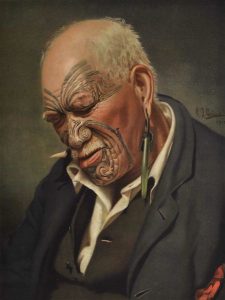
“A Warm Day” – by C. F. Goldie ( a Chromolithograph ) This hung on the wall in Ulleswater’s billiard room
Underneath the Robertson’s flat ran a concrete walkway from the Randalls’ flat entrance. It passed the letterboxes and the communal laundry with its copper and wringer above the grey-metal concrete wash tubs. Then it was on to Mr Randall’s workshop. From there you stepped down onto a driveway that led from High Street to a double garage. This driveway followed the Hipwood Street side of the house boundary. My father and Mr Randall shared the garage. I can still remember, when I was learning to drive, how close I came to hitting one of the sturdy, brick, gate posts at the entrance to this driveway. The turn from High Street was a very tight one, or that’s my excuse anyway.
Directly underneath the garage was a small flat, rented by Mr Preston, a friendly Englishman with a working class background. And that is pretty much all I can remember about him. Perhaps he was one of those people with a past that was better left in the past. He was always courteous to me and my family. He never socialised with the rest of the residents even though he resided there all my childhood.
This brief mention of Mr Preston made me realise that, during my time, the residents of Ulleswater stayed there for many years. I am sure that my father would have been Ulleswater’s longest staying tenant, arriving early in 1935 and not departing until 38 years later in 1973.
Prior to my childhood at Ulleswater, the North Sydney area had undergone very dramatic changes with the building of the Sydney Harbour Bridge. Not only were many homes demolished to make way for the Bridge but a ripple effect began which was to see change occur again, this time witnessed by me. The building of the Bridge led to an increasing number of cars using the North Sydney streets, as if drawn by a magnet to the city of Sydney. Then later in the day these cars would return, heading back over the Bridge to their north side homes. Office blocks started springing up in what was soon to be referred to as ‘the central business district’ of North Sydney. By this time the Warringah Expressway was under construction, cutting through the residential heart of our neighbourhood, as it championed its cause to improve our road system.
Ulleswater happened to be ideally positioned to observe these changes. A favourite place for my father to take photographs of his boys was our front landing. The backdrop to these snaps was the ever changing face of North Sydney. Such ‘back-to-school’ family snaps, as well as being a record of our own changing faces, inadvertently became a record of the changes to our suburb. My bedroom window also had the same view that was seen from the front landing. In 1962 I made a black-and-white ink drawing entitled High Street From My Window. In my drawing the MLC building definitely dominated the skyline. We had no trouble checking the daily predictions of its weather beacon, positioned on its summit.
Towards the end of 2021 I learnt that Ulleswater was facing demolition, to be replaced by a new block of apartments.The Heritage Impact Statement of September 2021 unsurprisingly concluded that Ulleswater’s ‘historical integrity’ and meaningful contribution to the area were now insignificant. It was believed that by replacing it with a newly proposed, three storey building, there would be no real impact on what is now referred to as the Careening Cove Conservation Area.
Even though it is over fifty years since I lived at Ulleswater, I was initially saddened by the news of its fate. I have made a couple of trips down from my home in Mt Victoria to see the old place again, before it quietly passes into memory.
© Jim Low November 2022
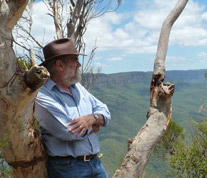
Jim Low is a singer/songwriter and published author.
His background is in education and he has also developed learning materials for the NSW Department of School Education. His passion is Australian history.
EMAIL: jim@jimlow.net WEBSITE: jimlow.net
Reference:
- Cyrus Williams memoir –
https://cyrusjohnrichardwilliams.weebly.com/william-williams—part-2–1865-1870.html
